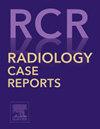Totally implantable venous access port metastasis in a patient with multiple myeloma
Q4 Medicine
引用次数: 0
Abstract
Multiple myeloma is a hematologic malignancy characterized by the proliferation of monoclonal plasma cells within the bone marrow. Extramedullary plasmacytomas, a rare manifestation of multiple myeloma, occur in a small percentage of patients. These plasmacytomas can develop in the skin, often near venous catheter access sites, posing diagnostic challenges due to their rarity. We report a case of a 63-year-old man with multiple myeloma who presented with a mildly painful, swollen left chest port site. A whole-body FDG PET/CT scan revealed a hypermetabolic soft tissue mass surrounding the port site, suggestive of malignancy. Subsequent surgical excision and histopathological analysis confirmed the presence of a metastatic subcutaneous plasmacytoma, consistent with the patient's known multiple myeloma. Cutaneous extramedullary plasmacytomas at central venous catheter sites are rarely reported. Potential mechanisms for tumor development at trauma sites include local expression of chemokines that attract myeloma cells. This case underscores the importance of recognizing cutaneous plasmacytomas in patients with multiple myeloma and venous access ports to avoid misdiagnosis and unnecessary interventions. It contributes to the broader understanding of extramedullary disease manifestations in multiple myeloma and emphasizes the need for thorough investigation and appropriate management in such cases.
一名多发性骨髓瘤患者的完全植入式静脉通路端口转移瘤
多发性骨髓瘤是一种以骨髓内单克隆浆细胞增殖为特征的血液系统恶性肿瘤。髓外浆细胞瘤是多发性骨髓瘤的一种罕见表现,发生在一小部分患者身上。这些浆细胞瘤可发生在皮肤上,通常靠近静脉导管通路部位,由于其罕见性,给诊断带来了挑战。我们报告了一例 63 岁的多发性骨髓瘤男性患者的病例,他出现轻微疼痛、左胸导管入口处肿胀。全身 FDG PET/CT 扫描显示,端口部位周围有一个高代谢软组织肿块,提示为恶性肿瘤。随后进行的手术切除和组织病理学分析证实了转移性皮下浆细胞瘤的存在,与患者已知的多发性骨髓瘤一致。中心静脉导管部位的皮肤髓外浆细胞瘤鲜有报道。创伤部位肿瘤发生的潜在机制包括局部表达的趋化因子会吸引骨髓瘤细胞。本病例强调了识别多发性骨髓瘤患者皮肤浆细胞瘤和静脉通路端口的重要性,以避免误诊和不必要的干预。它有助于人们更广泛地了解多发性骨髓瘤的髓外疾病表现,并强调了对此类病例进行彻底检查和适当治疗的必要性。
本文章由计算机程序翻译,如有差异,请以英文原文为准。
求助全文
约1分钟内获得全文
求助全文
来源期刊

Radiology Case Reports
Medicine-Radiology, Nuclear Medicine and Imaging
CiteScore
1.10
自引率
0.00%
发文量
1074
审稿时长
30 days
期刊介绍:
The content of this journal is exclusively case reports that feature diagnostic imaging. Categories in which case reports can be placed include the musculoskeletal system, spine, central nervous system, head and neck, cardiovascular, chest, gastrointestinal, genitourinary, multisystem, pediatric, emergency, women''s imaging, oncologic, normal variants, medical devices, foreign bodies, interventional radiology, nuclear medicine, molecular imaging, ultrasonography, imaging artifacts, forensic, anthropological, and medical-legal. Articles must be well-documented and include a review of the appropriate literature.
 求助内容:
求助内容: 应助结果提醒方式:
应助结果提醒方式:


